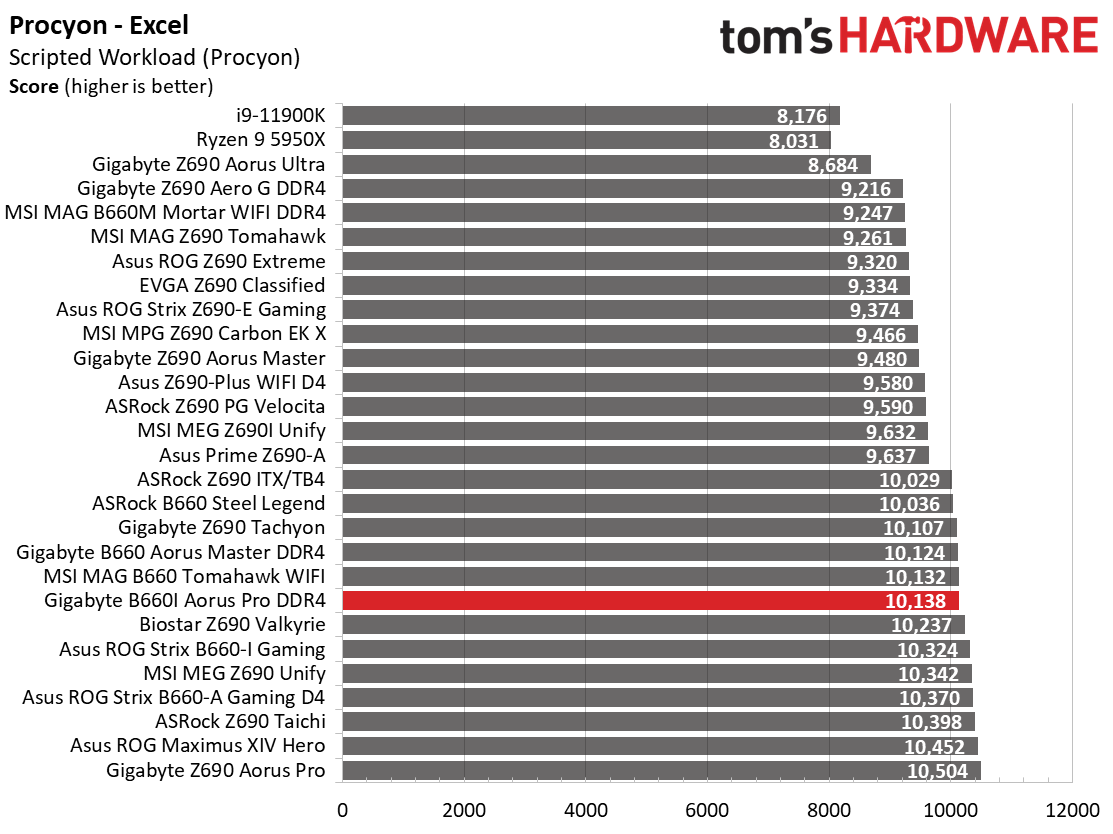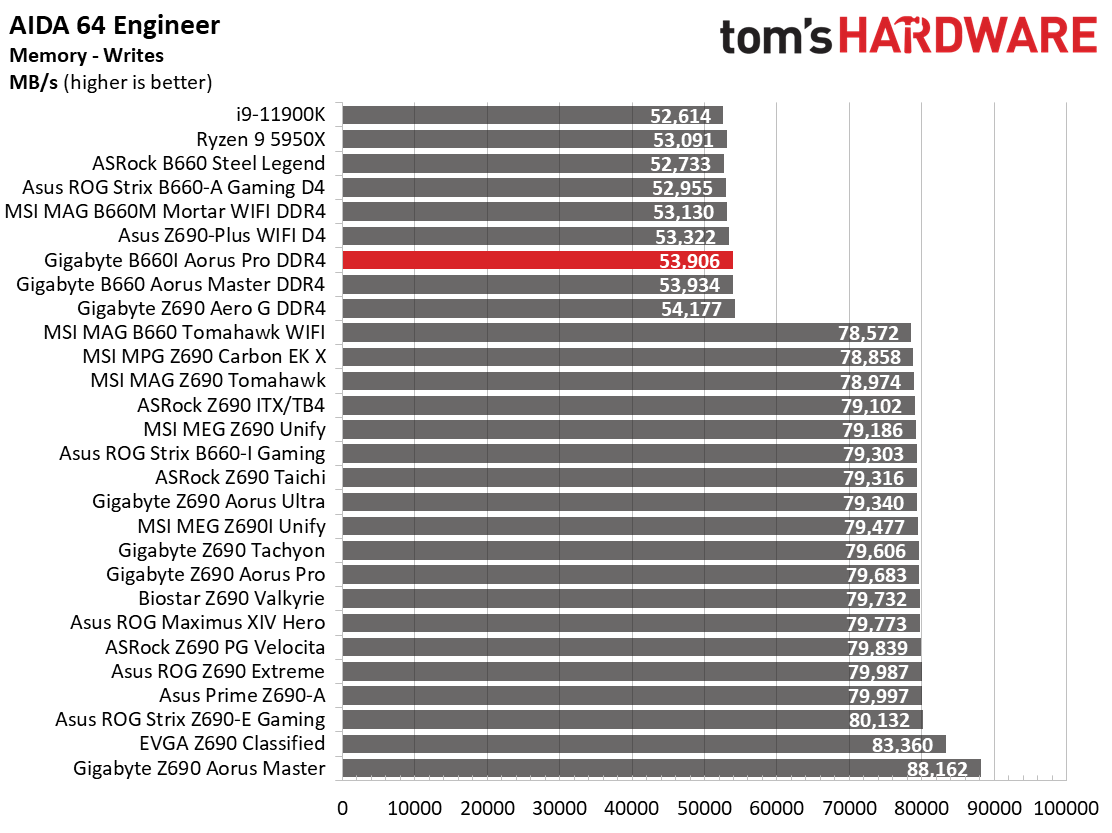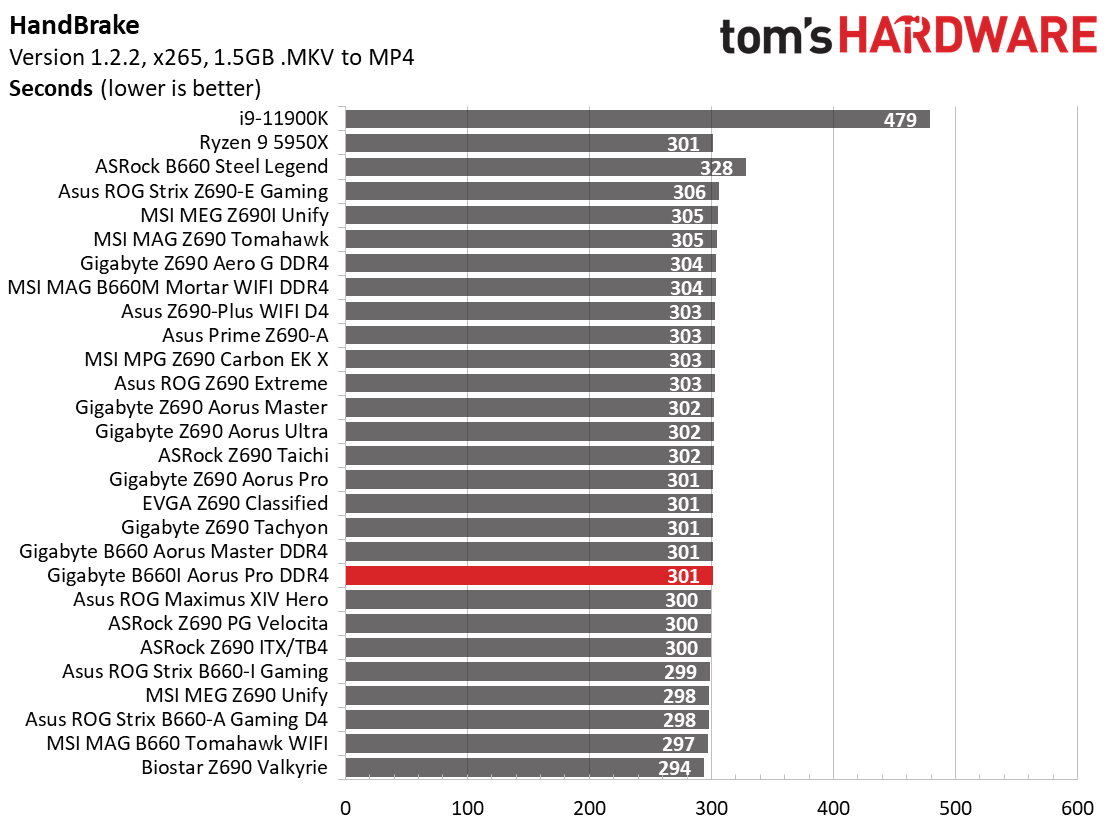Why you can trust Tom's Hardware
Our standard benchmarks and power tests are performed using the CPU’s stock frequencies (including any default boost/turbo), with all power-saving features enabled. We set optimized defaults in the BIOS and the memory by enabling the XMP profile. For this baseline testing, the Windows power scheme is set to Balanced (default), so the PC idles appropriately.
To get the most out of the Intel Alder Lake chips, you need to be on Windows 11 with its updated scheduler. In most cases, Windows 10 performs well. However, some tests (Cinebench R20, Corona and POVRay) take a significant hit. In short, if you’re going with Alder Lake, you must upgrade to Windows 11 for the best results across the board. That may change with patching and updates in the future, though.
Synthetic Benchmarks
Synthetics provide a great way to determine how a board runs, as identical settings should produce similar performance results. Turbo boost wattage and advanced memory timings are places where motherboard makers can still optimize for either stability or performance, though, and those settings can impact some testing.


















Results in our synthetic tests were average to above average for DDR4 boards, depending on the test. The B660I Aorus Pro did well across the Procyon Office tests and the Photo/Video Editing sections. The other tests (7Zip, Cinebench, and POV_Ray) were in line with the other similar boards.
Timed Applications




The B660I Aorus Pro DDR4 had good results in LAME, where its 9.57 second time was a bit faster than average. Corona testing wrapped up in 53 seconds, one second above the average for all tested boards. The x264 Handbrake result was the slowest among our DDR4-based boards at 119 seconds, but just a couple of seconds slower than average, while the x265 result was solid at 301 seconds. There’s nothing to worry about regarding performance in any of these tests either.
3D Games and 3DMark




Starting with the launch of the Z690 chipset, we’ve updated our game tests, updating to Far Cry 6 and shifting from F1 2020 to F1 2021. We run the games at 1920x1080 resolution using the Ultra preset (details listed above). As the resolution goes up, the CPU tends to have less impact. The goal with these settings is to determine if there are differences in performance at the most commonly used resolution with settings most people use or strive for. We expect the difference between boards in these tests to be minor, with most falling within the margin of error differences. We’ve also added a minimum FPS value, which can affect your gameplay and immersion experience.
In F1 2021, the B660-I Gaming averaged 163 frames per second (fps), with minimums of 139 fps, which is right around the middle of tested boards. In Far Cry 6, the Gigabyte ran the benchmark at 135 fps with a minimum of 124 fps. In the synthetic tests, our review board scored 14,136 on 3DMark Time Spy (one of the lowest results) and 16,918 on Fire Strike Extreme. Remember, these results are incredibly tight, with only a couple of percent between the fastest and slowest result. Out of the box, this board runs just a bit slower than most, but it would basically be impossible to notice without a frame counter or benchmark score.
Get Tom's Hardware's best news and in-depth reviews, straight to your inbox.
Power Consumption / VRM Temperatures

We used AIDA64’s System Stability Test with Stress CPU, FPU and Cache enabled for power testing, using the peak power consumption value. The wattage reading is from the wall via a Kill-A-Watt meter to capture the entire PC minus the monitor. The only variable that changes is the motherboard; all other parts are the same.
At idle, the DDR4-based B660I Aorus Pro used 43W (tied for one of the lowest results), with load wattage peaking at 342 Watts. The load wattage was slightly above average and, between the two, the board sits in the middle of the tested alternatives.


During stock stress testing, we saw the processor throttle due to the board’s liberal use of voltage by default. Sadly, this behavior isn’t new and quite common for the platform. The beefy VRMs ran surprisingly warm during our test, peaking over 70 degrees Celsius on the Extech and the internal sensor. These temperatures are well within spec. I’m surprised the 90A power delivery ran as warm as it did. Mind you, this is during stress testing, which is, typically, the worst-case scenario. So temperatures will be lower when gaming or doing other less-stressful activities.
Overclocking

Overclocking the CPU isn’t possible on B660-based chipsets, but the platform allows memory speed adjustment. With our DDR4-3600 and DDR4-4000 kits, we simply set XMP and off we went without a hitch. Being an ITX board, there’s likely some headroom left, but I’d imagine people purchasing the less expensive boards (versus Z690 ITX) won’t look to buy expensive RAM that’s far outside the sweet spot (around DDR4-3600/4000).
Bottom Line
Gigagbyte’s B660I Aorus Pro DDR4, by all accounts, should be a more budget-friendly board considering the chipset and DDR4 memory support. At $245.99, it’s more comparable in price to Z690 Mini ITX boards. But among its B660 peers, it’s the highest-priced of the bunch. For the most part, the Aorus Pro DDR4 is well-equipped, offering users overkill power delivery, 2.5 GbE and Wi-Fi 6, four SATA ports, and a single M.2 socket. There are enough USB ports available on the rear IO and more through headers, though the board is missing a 20 Gbps port.
Compared to the much less expensive ASRock B660M-ITX/AC ($119.99), our Gigabyte holds its own with the overkill VRMs, USB port count and appearance, but falls short in M.2 socket count and Wi-Fi speed (AC vs. Wi-Fi 6). The Asus ROG Strix B660I Gaming WIFI costs $25 less ($219.99), includes a 20 Gbps USB port, PCIe 5.0 slot, DDR5 memory support (increasing overall costs), Realtek ALC1220 codec, dual M.2 sockets and a premium appearance (but without RGB LEDs).
In a vacuum, we like what the Gigabyte B660I Aorus Pro DDR4 has to offer. There's a lot to like, from the overkill power delivery to the premium appearance and RGBs. However, it’s not the only B660 ITX board out there. If the price were lower than the Asus (around $199), the choice between the two would be more difficult. As it stands, the Gigabyte is a capable Mini ITX board that covers the basics, but its current price makes it tough to pick over the Asus, regardless of the higher cost of DDR5.
MORE: Best Motherboards
MORE: How To Choose A Motherboard
MORE: All Motherboard Content

Joe Shields is a staff writer at Tom’s Hardware. He reviews motherboards and PC components.
-
shady28 Good to see you guys doing more mATX and ITX board reviews.Reply
One suggestion on motherboard reviews. Test the M.2 performance and one of the higher speed USB 3.2 ports.
I've noticed on other sites, some motherboards can have much slower real world performance on the M.2 and USB ports than otherwise identically setup boards with the same chipset.
I believe this is why some of your boards are showing up under performing on the compression tests. The differences in this area can be significant. Example below.